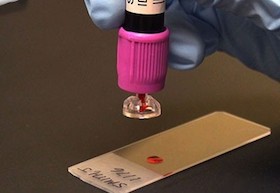How do Blood Dispensers work and what are the benefits?
27 August 2019

Working with blood samples can be an unpredictable and messy affair, with technicians needing to be incredibly careful to avoid any contamination of blood samples from airborne or bloodborne pathogens whilst delivering uniform smears each time.
In high pressure environments such as Accident and Emergency or ER departments of hospitals, epidemic diagnosis clinics and large scale doping testing centres, the likelihood of spills, leaks and contamination of samples can increase further. This can make testing more susceptible to pre-analytical variability and lead to skewed results so it is crucial to make the blood sample collection and handling process as consistent and risk free as possible.
One major solution to limit incidents of this nature is the use of a Blood Dispenser. Blood dispensers enable the preparation of blood slides from a blood collection tube without removing the stopper and exposing the sample within to the outside environment. One popular brand is the SmearSafe Blood Dispenser which works with Vacutainer® and Vacuette® collection tubes which are commonly used in haematology, blood bank, phlebotomy, and general laboratory settings.
How does a blood dispenser work?
Blood dispensers have been designed to compatible with as many common laboratory processes and blood testing supplies as possible. The cannula of the Smearsafe device fits directly into the rubber stopper of the collection tube without any extra holes needing to be made or any sections of the lid needing to be removed.
The tube can then be inverted and the dispenser can be pressed against the slide, as you would do with a fountain pen or glue dispenser, and blood is applied neatly. To apply more blood, apply more pressure for longer. This technique is used for manual slide staining, with automatic slide stainers available for more demanding requirements or volumes.
What are the benefits of using blood dispensers?
With a SmearSafe blood dispenser it is possible to control the size of the drop applied to each slide based on the speed of delivery and amount of pressure applied to the tube, so staff can create almost identical samples for an equal comparison. With this level of regulation, it is also possible to keep track of how much blood has been dispensed and how much remains within the tube, so supplies are not used too quickly or over-rationed.
The direct dispensing from the tube also makes the blood dispensing process far quicker and easier than having to rely on applicator sticks or capillary tubes which make use of open, glass test tubes. With reduced technician fatigue this means less human error, so fewer tests require repeating and diagnoses can be reached and treatment started more quickly.
When the testing phase is complete, disposal is also straightforward as the whole unit can be discarded in a sharps medical waste container. This again reduces infection or exposure and creates a closed loop for the whole process.
Whether a laboratory is handling haematology, phlebotomy, paternity or blood grouping samples, having accurate and timely samples is a top concern. These processes and benefits can make the smear process as safe and efficient as possible, keeping demands on staff and budgets low. Learn more at the Smearsafe product page.
< Back to blog list
Share




